Understanding Common Denial Codes in Medical Billing: Reasons & Solutions
There lack of standardization within the healthcare system that leads to denials. But, what exactly do all of these denial codes in medical billing mean and how do you stop them from happening?

There are between 5 and 10 percent medical claim denials on average, according to the AAFP.
But this isn’t necessarily a set average. You see, there are many different studies that yield different results. Though not many of these results seem to fall below that range.
Another report by the Centers for Medicare and Medicaid Services (CMS) for instance reports differently. In 2020, across HealthCare.gov insurers, reports show that 18 percent of in-network claims resulted in claim denials.
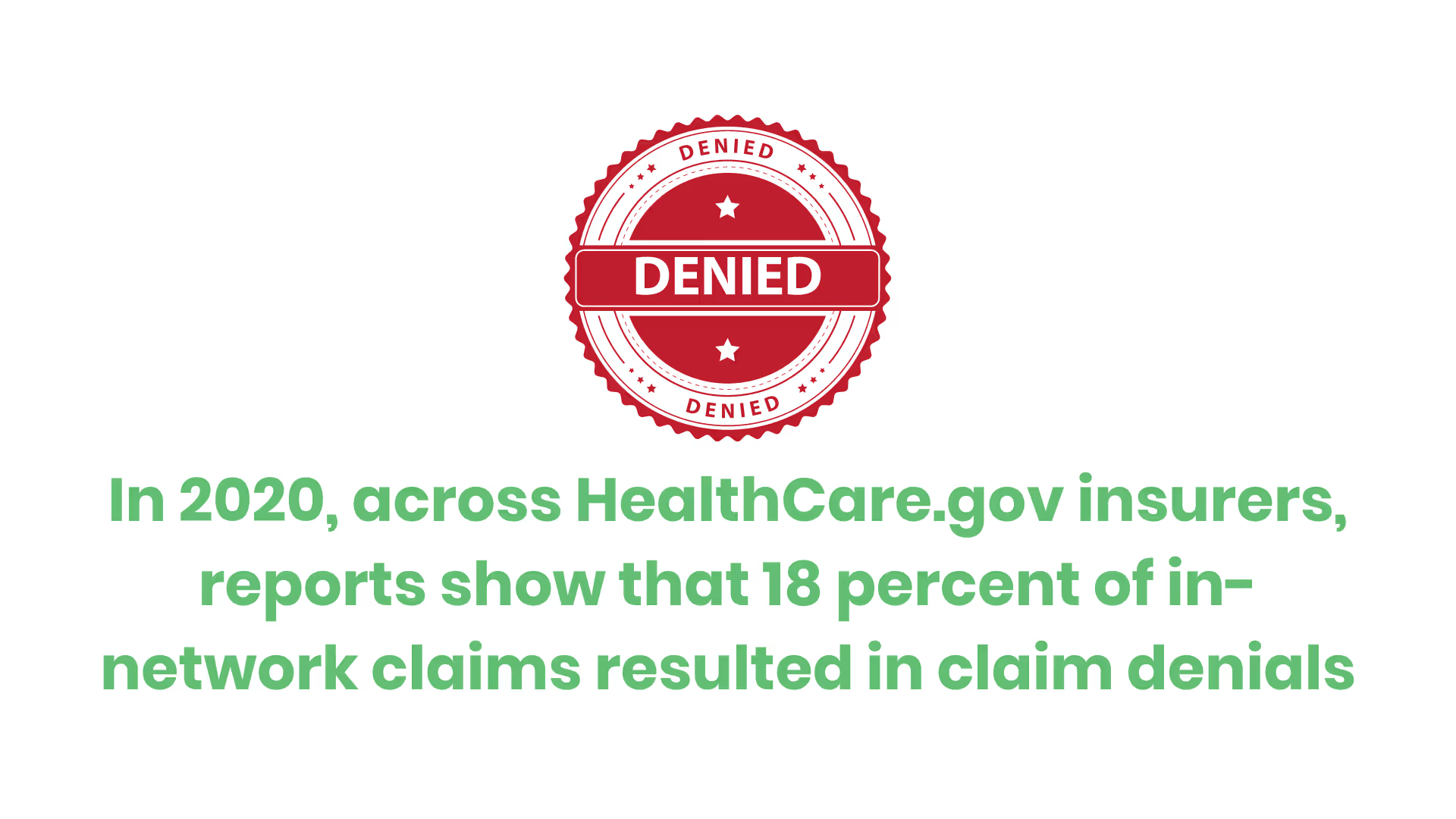
These denial rates vary from individual providers as well. This is largely due to the lack of standardization within the healthcare system. And as you can see, this showcases the struggles that facilities have with denial management services on a daily basis.
The good news is, there is standardization when it comes to the denial codes themselves. But what are denial codes? Let’s dive in.
What is a denial code in medical billing?
Let’s start with the overarching question of: what are denial codes?
These are codes that insurance companies use to signal an incorrect insurance claim.
They will send these straight back to providers as an explanation as to why they will not be covering the billed service, treatment, or medication. The good news is that by receiving these codes, you are well on your way to figuring out what the heck went wrong and how to correct it.
Within the denial codes, there is helpful information that will tell you exactly what is wrong… you just need to know how to read it. Introducing the electronic remittance advice (ERA). ERAs are an explanation from the insurance provider about how they adjust claim charges based on aspects like:
- Contract agreements
- Secondary payers
- Benefit coverage
- And more
What are ERAs also good for? For getting more information, of course! You can find more denial code information by thoroughly reading the ERA. This information might include claim adjustment group codes (CAGR), claim adjustment reason codes (CARC), and remittance advice remark codes (RARC). Let’s go over what each of these are!
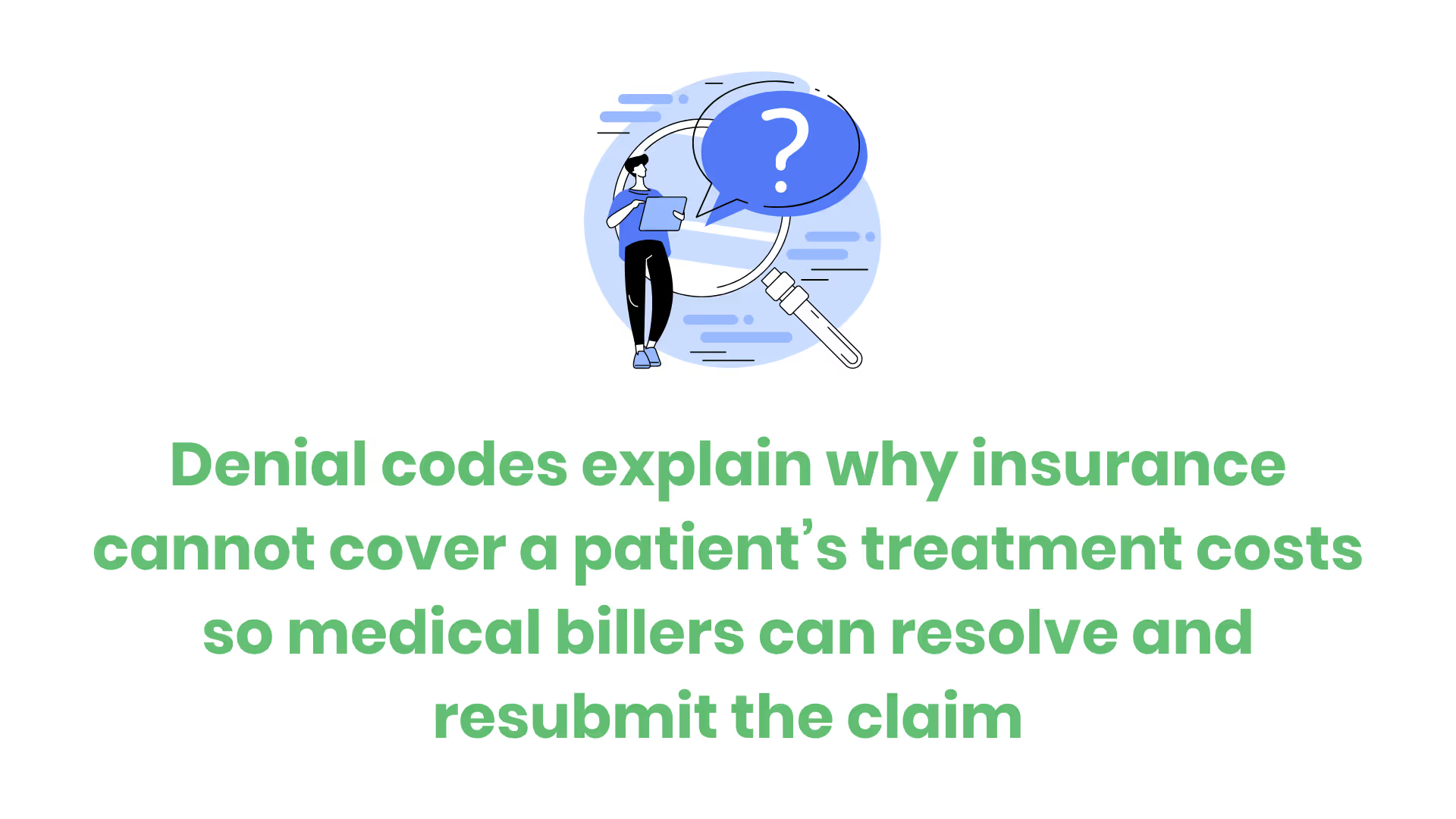
Understanding Adjustment and Remark Codes
Claim Adjustment Group Code
Claim adjustment group codes (CAGCs) are a combination of two alpha characters. These codes can help determine the financial duty of the remaining claim balance. In other words, who is in charge of paying.
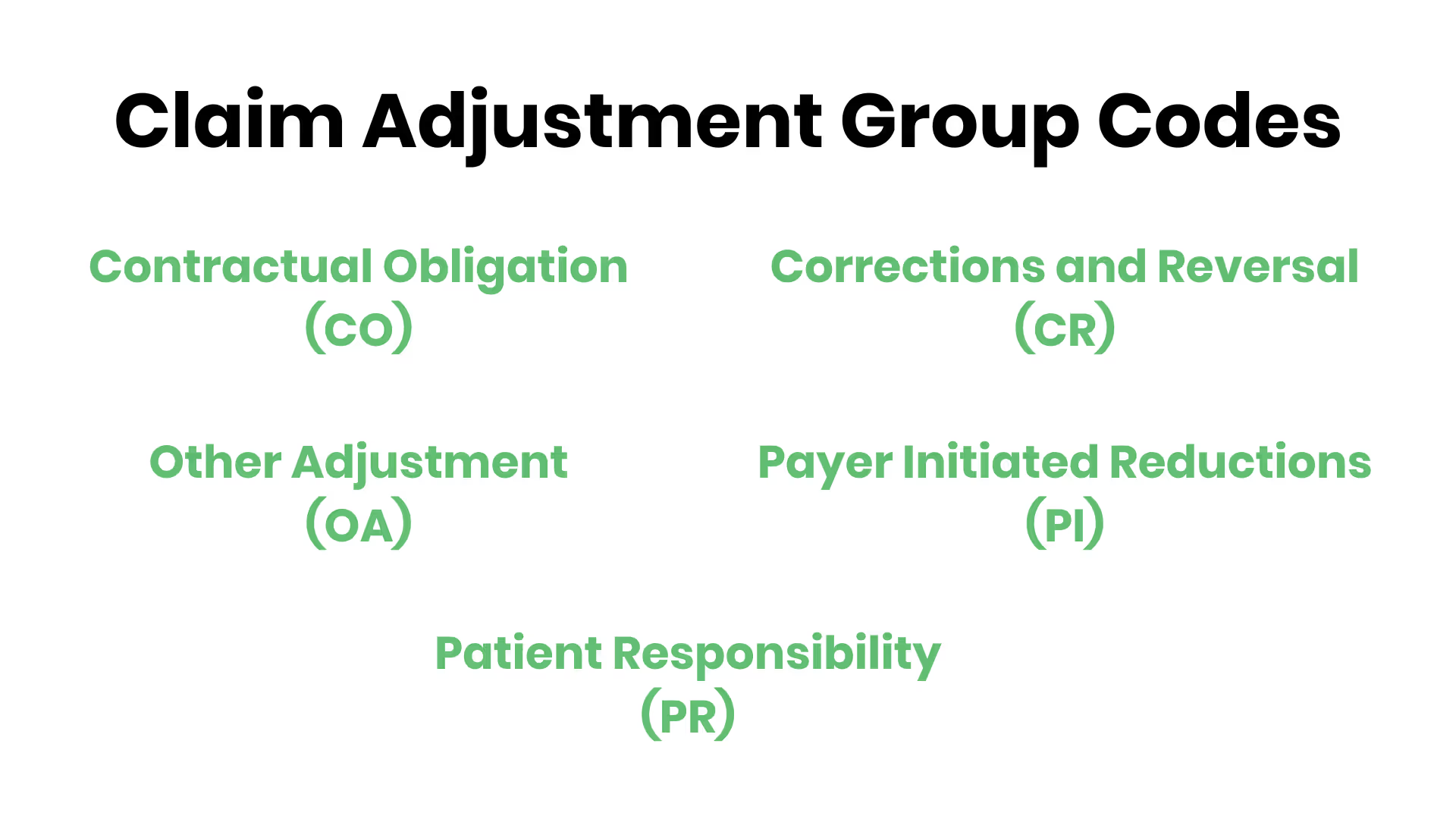
Here are the five CAGCs and what they stand for:
- Contractual Obligation (CO): this code indicates that the amount between what the practice/provider bills and the amount allowed by the payer. This is of course when you are in-network with them. This amount is what the provider must adjust from the claim and the patient is not responsible for this amount.
- Corrections and Reversal (CR): this code marks that payers corrected or reworked a formerly adjudicated claim. You can use the CR code with CO, PR or OA to note revised information.
- Other Adjustment (OA): billing professionals use this code when CO nor PR apply. In other words, this applies when there is no contractual obligation or patient responsibility on the claim. The claim is fully paid. These are oftentimes referred to as “group code oa”.
- Payer Initiated Reductions (PI): a payer may use this code when they believe the adjustment is not the responsibility of the patient. Check the reason code for additional information about this code.
- Patient Responsibility (PR): this code helps patients understand which portion of the bill they are responsible for. These may include copays, deductibles, and coinsurance amounts. You will also see this code if the patient does not have coverage on the date of service.
Claim Adjustment Reason Code (CARC) & Remittance Advice Remark Code (RARC)
Claim adjustment reason codes (CARCs) are handy when determining claim financial adjustments. If the payer does not make any adjustments to the claim, then don’t expect there to be a CARC!
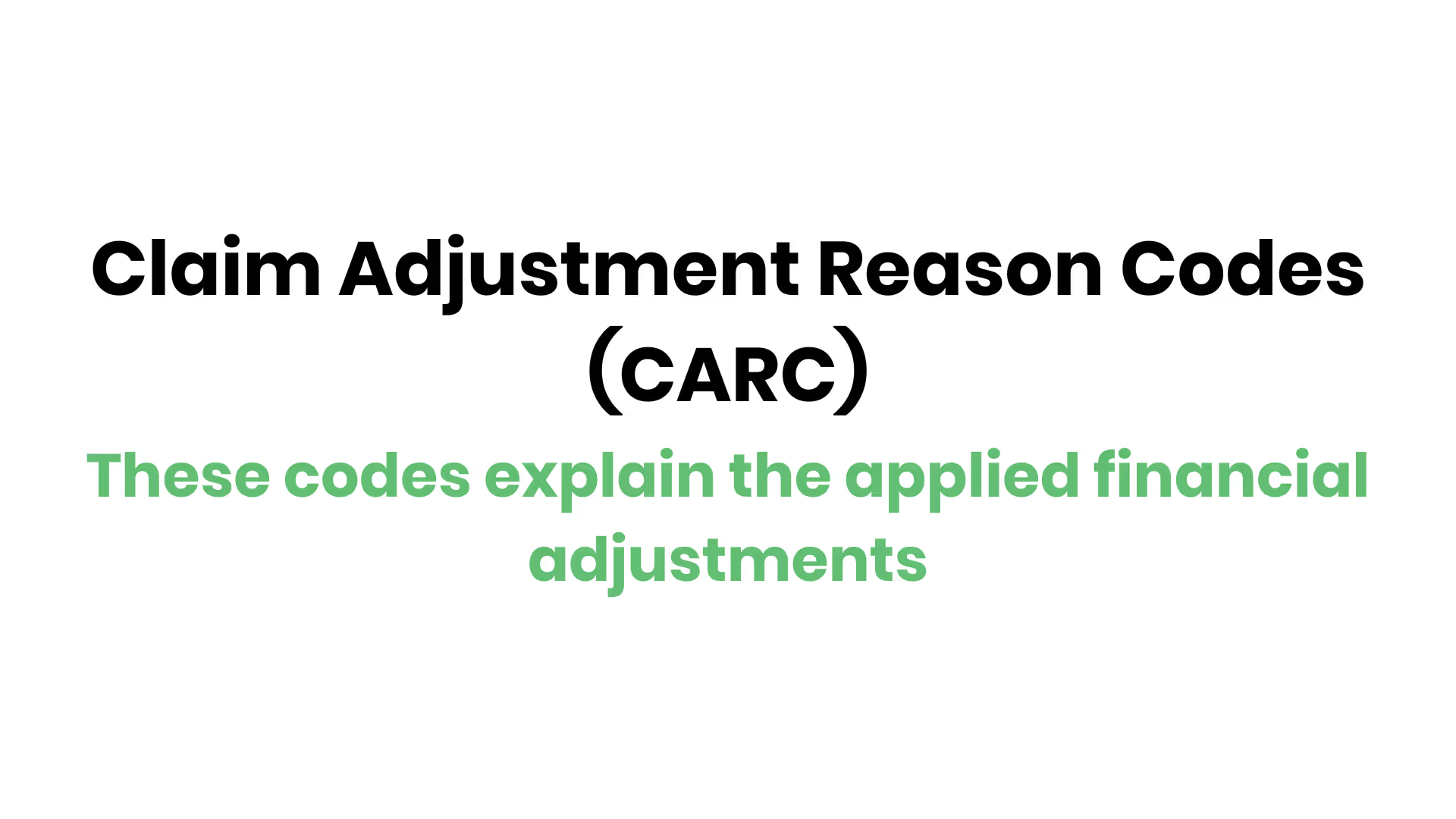
Remittance advice remark codes (RARCs) help by providing any additional information for the reasons spelled out by the CARCs. When talking about types of RARCs there are two: Supplemental and Informational.
Supplemental RARCs or “RARCs without further distinction”, provide further explanations for the already described CARCs. Informational RARCs are alerts that convey details about remittance processing.
Under the Health Insurance Portability and Accountability Act (HIPAA), payers must use CARCs and RARCs approved by X12 recognized code set maintainers. By using these, you can readily explain any adjustment code in a claim payment.
You can also request new codes or suggest existing code revisions through the CARC and RARC Committees. The requests must include suggested wording for the new or revised code. They must also include an explanation of how to use the code and why it is necessary.
The CARC Committee is open to review these requests 3 times a year while the RARC Committee reviews them 12 times a year.
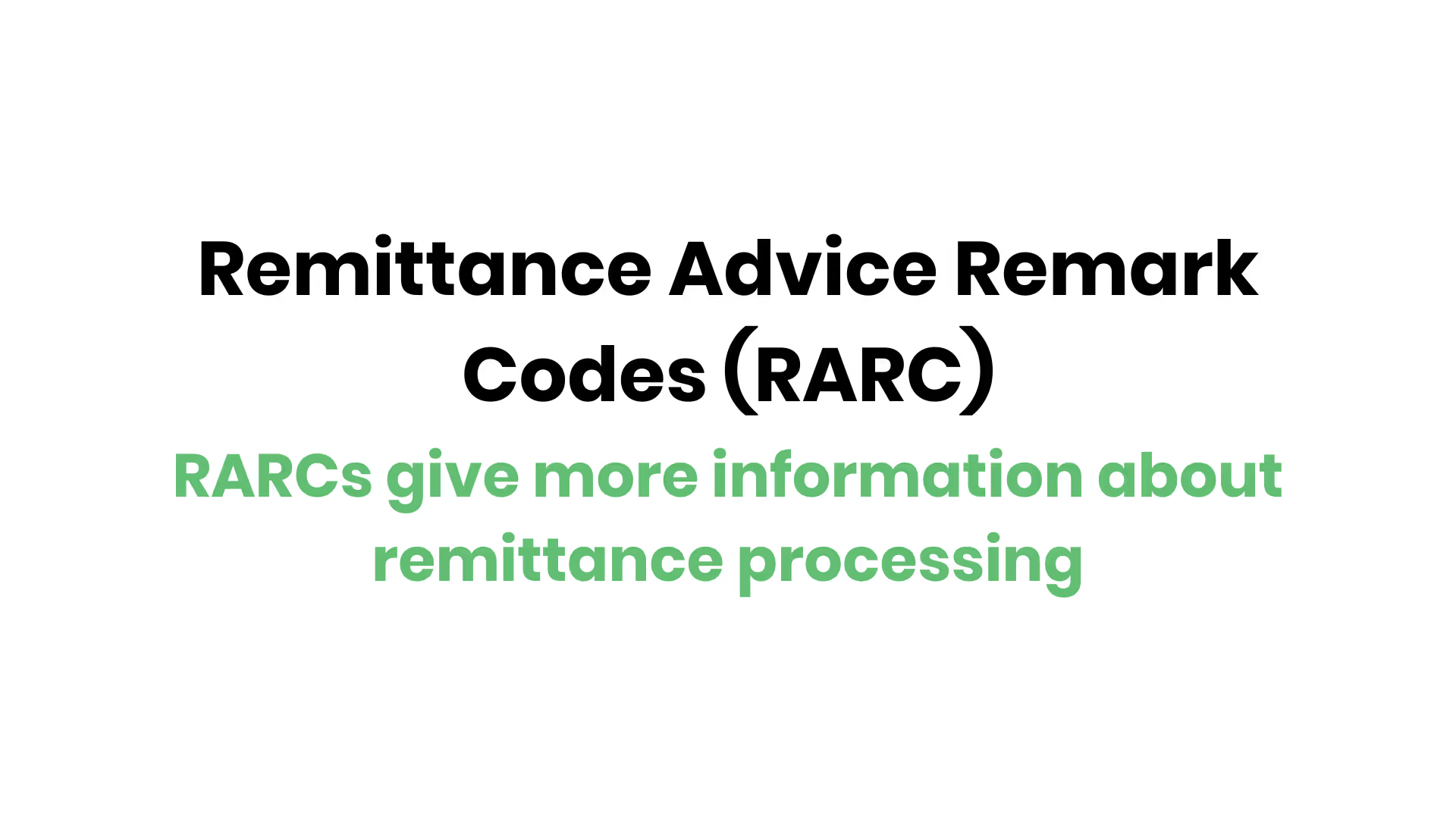
Why Do Denials Occur? Common Reasons Explained
While denial management is a part of the job for medical billing professionals, let’s put things into perspective for a moment. According to Change Healthcare, the average cost to rework a denial is about $25 (additional cost).
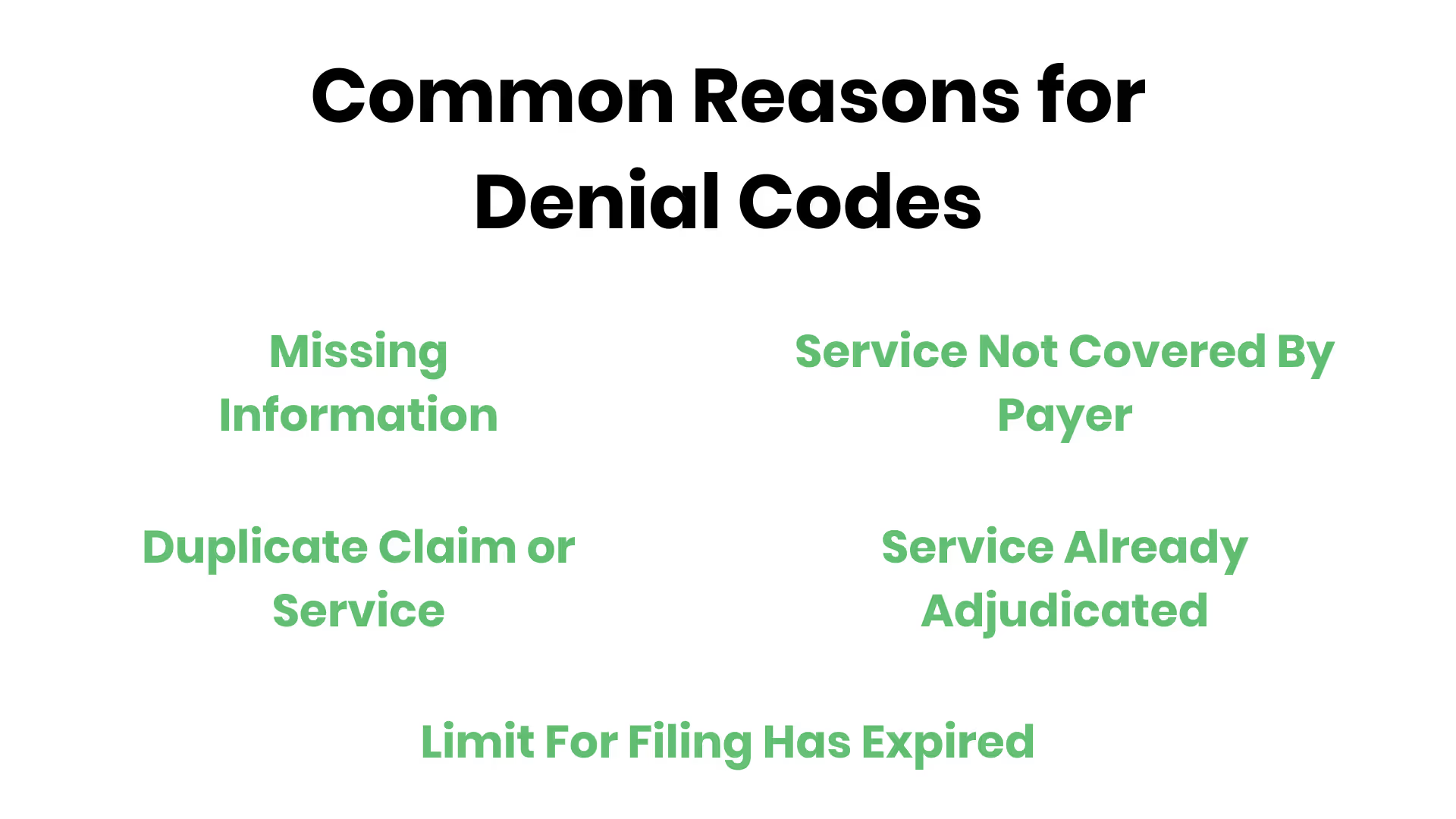
Running a business comes down to dollars and cents. It goes without saying that when you run a practice, you’ll want to lower operating costs in any way you can. Reducing your practice’s claim denial rates will thus reduce that extra cost. So what is a good way to reduce receiving denials? Familiarize yourself with the denial codes!
There are many different reasons a claim might face a denial code such as:
- Missing or inaccurate data
- Lack of prior authorization
- Lack of medical necessity
- Patient eligibility
- Duplicate/late submissions
Unfortunately, even without a denial, these tasks have their own administrative burdens. Let’s take prior authorization for example. A study by the American Medical Association reports that prior authorization work takes an average of 14 hours (almost 2 business days) each week to complete.
So add on dealing with claim denials and you are looking at a lot of administrative time and effort wasted. Even more of a reason to know your codes. By doing so, you can not only rework claims faster, but hopefully learn to avoid similar denials in the future. Here are a few common claim denial codes you should know, and how to handle them.
What are Common Denial Codes in Medical Billing?
CO 1 – Maximum Benefit Reached
When you encounter CO 1, it indicates that the patient's maximum benefit for a particular service or time frame has been reached. This can be frustrating for both the patient and the provider, as it often means that the billed services will not be covered by the insurance.
What does this mean for your claim?
The denial suggests that the insurance company believes the patient has exhausted their coverage limits, either for the year or for a specific type of service.
CO 4 – Procedure Code Is Inconsistent with the Modifier Used
Insurance companies send out denial code CO 4 when a required modifier is missing or the procedure code is inconsistent with the modifier used. You’re probably thinking, “What is a modifier?” Let’s detour from CO 4 for a minute.
A modifier is a 2 character numeric (or alphanumeric) code that couples with CPT codes to flag that there is an alteration of a service without changing the code or definition. Without the correct modifiers you can expect to have a difficult time receiving payments.
So if you receive denial code CO 4, here are a few things you can do to take action:
- Review to see if the coding team really did use the incorrect modifier or perhaps forgot to apply it.
- If this is the case and your team did miss adding the correct modifier, update the mistake and resubmit your claim.
If you find your coding team did forget to apply the appropriate modifier, consider these steps:
- If the insurance denies your claim even with the correct modifier, you can reach out to the claims department so they can reprocess it.
- If they disagree, you can take the final step of submitting an appeal with any supporting documents you have.
CO 5 – Procedure Code/Bill Type Is Inconsistent with the Place of Service
When you receive CO 5, it means that the procedure code submitted does not align with the designated place of service (POS). This commonly occurs when a procedure that is typically performed in an outpatient setting is billed as an inpatient service, or vice versa. It can also arise if a provider performs a service at a location where they are not credentialed.
What does this mean for your claim?
CO 5 suggests that the payer has flagged a mismatch between the billed service and the location where it was performed.
CO-6 – Patient Is Not the Primary Beneficiary
CO 6 arises when the billed patient is not the primary beneficiary of the insurance policy. This situation can lead to confusion and denial of claims if not properly addressed beforehand.
What does this mean for your claim?
This denial typically indicates that the services were billed to an insurance policy under which the patient does not have primary coverage. This could happen in cases of dependents or other insured members who are not the primary holder of the insurance.
CO-8 – Procedure Code Is Inconsistent with the Provider Type
CO 8 is triggered when there is a discrepancy between the performed procedure and the provider’s specialty or type. This denial can occur if a procedure typically not associated with a provider’s specialty is billed, leading to questions about the appropriateness and authorization of the service.
What does this mean for your claim?
This type of denial highlights the need for proper alignment between a provider’s credentials and the services they render.
CO-9 – Diagnosis Is Inconsistent with the Patient’s Gender
CO 9 occurs when the diagnosis submitted does not align with the patient’s gender, leading to claim rejections. This can happen due to a variety of reasons, including clerical errors or a misunderstanding of gender-specific medical guidelines.
What does this mean for your claim?
This denial points to a mismatch between the patient's gender and the medical diagnosis or treatment billed.
CO 11 – Diagnosis Code Does Not Match the Procedure
When looking at common denial codes, CO 11 is one of the more prevalent ones.
To put it plainly, CO 11 stands for a claim with a diagnosis code that does not match with the procedure. A diagnosis code is an important tool used to define the medical concern during a doctor visit. This diagnosis code must then be consistent and relevant for the medical services mentioned. If not, you will receive denial code CO 11.
Oftentimes you receive this denial code because there’s a mistake in the coding. An incorrect diagnosis code is likely the culprit, so the first thing to do is to check for that. Refer to your coding team and look over the patient’s record to ensure that there is not a typo or another error.
If there is an error or a diagnosis that is missing, use this information to correct the claim and resubmit it. However if you cannot find an error, you have the option to appeal the claim. Remember that if you do decide to appeal the claim, always provide any records that back up the medical necessity of the procedure for the diagnosis.
CO 15 – The Authorization Number Is Missing, Invalid, or Does Not Apply
Denial code CO 15 means that the claim you entered has the wrong authorization number for a service or a procedure.
You will need prior approvals to receive proper coverage for certain procedures or treatments. After you gain this approval, you must then enter the correct prior authorization number in block number 23. This block is on the CMS-1500 form.
Receiving this denial code means there is a hiccup somewhere in this process. You should address this denial code first by:
- Review claim to see whether your team submitted the prior authorization request.
- Recheck block number 23 for any errors.
If the pre-authorization information is not available, attempt to get retro-authorization for the claim.
CO 16 – Claim Lacks Information or Has Missing/Incorrect Modifiers
Denial code CO 16 is probably one of the most common denial codes you will come across. You will receive a CO 16 code if you submit a claim with missing information or missing/incorrect modifiers. Some other reasons for CO 16 include:
- Demographic errors.
- Technical errors.
- Invalid Clinical Laboratory Improvement Amendments (CLIA) number
- Missing social security number
To fix CO 16 claim denials, you should pay attention to any accompanying remark codes. These remark codes are there to help you further define what information is missing so you can make changes accordingly.
CO 18 – Duplicate Claim Submission
Payers use the denial code CO 18 with RARC N522 to deny duplicate claims, which happens if you:
- Submit the same claim twice for a service, medication, or treatment.
- Resubmit a claim without letting the insurance company know you corrected it.
- Provide the same service multiple times on the same day without a modifier.
A specific example might look something like the following: Say you are eager to make sure a specific claim goes through processing as quickly as possible. You send the claim to both the patient’s primary insurance and their secondary insurance. Essentially you are just trying to receive reimbursement from either one.
But what you didn’t know is that the primary insurance provider already sent the claim to the secondary payer. Now, the secondary insurer denies your claim because it is a duplicate. Quick note here, you can check the electronic remittance advice to see whether or not the primary insurance provider crosses a claim over to the secondary one. This of course saves you from needing to resubmit the claim and deal with time-consuming claim denials.
When dealing with claim denial CO 18, you should first contact the insurance provider. By doing so you can quickly uncover any duplicate reasons you might otherwise be unaware of and also verify the claim’s processing status. If you are sure you submitted the claim only once, you can request the health plan company to reprocess it. Alternatively, you can also file an appeal if there seems to be no reasonable cause for the denial.
CO 22 – Care May Be Covered by Another Payer Per Coordination of Benefits
I touched on this while talking about denial code CO 18, but sometimes a patient may have more than one payer. I’m talking about primary, secondary and tertiary insurance providers of course. This coordination of benefits can confuse the billing process and complicate collecting on reimbursements.
For example, if you bill secondary insurance companies for services only covered by primary providers, they will deny the claim and send back denial code CO 22. To avoid this denial code, submit the claim to the primary health insurance plan first. After that, you can then send the remaining balance to the secondary or tertiary providers.
Another way to avoid running into denial code CO 22 is to make sure patients’ insurance information is up to date as well as coordination of benefits information.
CO 23 – Services Excluded from Coverage
Denial code CO 23 is issued when a claim is made for services that are explicitly excluded from a patient’s insurance coverage. This can lead to unexpected costs for the patient and reimbursement issues for providers.
What does this mean for your claim?
This denial indicates that the charged services are not covered under the patient's current insurance plan due to specific exclusions.
CO 26 – Expenses Incurred Prior to Coverage
CO 26 is issued when a claim is submitted for services provided before the patient’s insurance policy became active.
What does this mean for your claim?
The payer denied the claim because the service date occurred before the policy’s effective date.
CO 27 – Expenses Incurred After Coverage Terminated
You can expect to receive denial code CO 27 when a patient undergoes services or treatment after their health insurance expires. Unfortunately, this denial code is pretty difficult to resolve. That is why it is important to perform insurance eligibility verification checks before seeing the patient.
However, if you do come across CO 27 denials, consider the following:
- Confirm the insurance policy’s effective and expiration dates.
- See if the patient has any secondary insurers.
- Appeal the claim if the policy is still active. It might be a mistake by the insurance provider!
- If the patient doesn’t have active insurance, bill them directly.
CO 29 – The Time Limit for Filing Has Expired
Denial code CO 29 means that you sent a claim after the submission deadline. Each health plan has its own claim submission timeframe, so make sure you are familiar with your payer’s!
If you receive denial code CO 29, make sure to:
- Check the date you submitted the initial claim.
- Review the date submitted and calculate whether this happened before the filing deadline.
- Take proof of timely filing to file for an appeal.
CO 39 – Services Denied at the Time Authorization/Precertification Was Requested
CO 39 is issued when a service was not authorized at the time of the precertification request. This means that the insurance company denied the prior authorization request before the service was performed.
What does this mean for your claim?
The payer declined to approve the procedure in advance, which means the service is not covered under the patient’s policy.
CO 45 – Charge Exceeds Fee Schedule or Contractual Agreement
If you receive CO 45, this marks a fee that exceeds the maximum amount allowed for a service charge. This can also mark when a service charge exceeds a contracted fee arrangement.
It is important to remember with this denial code that the adjustment amount cannot equal the total service charge amount. Also please note that the adjustment must not duplicate provider adjustment amounts from previous payer decisions.
Unlike many denial codes, there is some good news with CO 45. You will generally receive some money back in a paid claim with this denial… just not the entire balance. So when the claim processes there is an amount that the payer can accept, but the rest is a write-off.
CO 50 – Lack of Prior Authorization
Encountering CO 50 can be a significant hurdle, as it signifies that the service was rendered without the necessary prior authorization from the insurance provider. This is a common issue that can lead to unpaid claims, affecting your revenue cycle management.
What does this mean for your claim?
This denial indicates that the healthcare service provided was not pre-approved by the insurance company, which is often a prerequisite for coverage.
CO 55 – Procedure/Treatment/Diagnosis Is Deemed Experimental or Investigational
CO 55 is used when a payer considers a treatment or procedure to be experimental, investigational, or unproven. This often applies to new medical technologies or treatments that lack long-term clinical data.
What does this mean for your claim?
The payer denied payment because they do not recognize the procedure as standard medical care under their policy.
CO 59 – Only One Visit Per Day Is Covered
CO 59 occurs when a provider submits claims for multiple services on the same day that exceed the insurer’s coverage limits. Some insurance plans only allow one visit per day for certain procedures or specialties.
What does this mean for your claim?
The insurer is rejecting additional claims for services performed on the same date, indicating that only one service per day is reimbursable.
CO 97 – Service Already Adjudicated or Included in Another Procedure
CO 97 is issued when a claim is rejected because the service has already been adjudicated or there is insufficient information to process it further. This can happen if the claim is resubmitted without addressing previous issues or if key details remain missing.
What does this mean for your claim?
The insurer is indicating that the claim has already been reviewed and processed (or partially processed), and a resubmission has not provided the necessary additional information to change that decision.
CO 104 – Processed According to Contractual Agreement/Legislation
CO 104 means that the claim was adjusted due to contractual obligations or legislative policies. This typically occurs when a payer reimburses based on predetermined fee schedules, state laws, or provider agreements rather than the billed amount.
What does this mean for your claim?
The insurance company is indicating that they have processed the claim based on existing agreements or regulations, which may result in reduced payment or non-payment.
CO 107 – Claim Denied Because the Related or Qualifying Service Was Denied or Unpaid
CO 107 is issued when a service is dependent on another procedure that was denied or unpaid. This often happens with bundled services, pre-op visits, or follow-up care tied to an initial procedure.
What does this mean for your claim?
The insurer denied the claim because the primary service it was linked to was also denied or remains unpaid.
CO 122 – Non-Covered, Charge Exceeding Fee Schedule/Maximum Allowed
CO 122 occurs when a charge exceeds the maximum amount the insurer allows for a specific service under the patient’s policy.
What does this mean for your claim?
The insurer denied or adjusted payment because the charge was above the payer’s fee schedule or coverage limits.
CO 150 – Payer Deems the Information Submitted Does Not Support This Level of Service
Insurance companies use CO 150 when the submitted documentation does not justify the level of service billed. This typically happens when evaluation and management (E/M) codes, procedures, or treatments exceed what the payer considers appropriate based on the medical records provided.
What does this mean for your claim?
This denial suggests that the payer believes the claim was billed at a higher level than what was medically necessary or documented. The insurer may determine that the complexity, time, or resources used do not align with the level of service submitted, leading to a denial or claim adjustment.
CO 151 – Payment Adjustment Due to Payer’s Limitation on Days or Units of Service
Insurance companies use CO 151 when a claim exceeds the payer’s allowed number of service units, visits, or days covered within a specific period. This often applies to physical therapy sessions, diagnostic tests, hospital stays, or other time-restricted treatments outlined in the patient’s policy.
What does this mean for your claim?
This denial suggests that the payer believes the service has surpassed the allowed limit for coverage under the patient’s insurance plan. It may indicate that the patient has used all allotted visits or units, that the claim was billed incorrectly, or that prior authorization was required for extended services but not obtained.
CO 167 – Diagnosis Not Covered
At the end of the day, health insurance plans can’t cover every procedure a patient might need. In these cases, payers will use denial code CO 167 to reject the claims that don’t fall under their coverage.
When handling denial code CO 167, you should:
- Review (ICD-11) diagnosis codes in case of errors.
- Contact your payer to find out which diagnoses are not covered.
- Make any adjustments necessary, then resubmit the claim as corrected.
CO 197 – Precertification or Authorization Required but Not Obtained
Insurance companies use CO 197 when a service requires precertification or prior authorization, but the provider failed to obtain approval before rendering the service. Many insurance plans have preauthorization requirements for procedures, surgeries, imaging services (such as MRIs or CT scans), and specialty medications to ensure medical necessity and cost control.
What does this mean for your claim?
This denial suggests that the payer rejected the claim because no authorization was on file, the request was denied, or the authorization number was missing from the claim. Without proper precertification, the payer will not reimburse the service, leaving the provider or patient responsible for the cost.
CO 222 – Service Denied Based on Utilization Review
Insurance companies use CO 222 when a service is deemed medically unnecessary or overutilized based on their utilization review criteria. This means the payer believes the procedure, treatment, or duration of care exceeded what is deemed appropriate under the patient’s plan.
What does this mean for your claim?
This denial suggests that the payer questions the necessity, frequency, or appropriateness of the service provided. It could be due to missing documentation, failure to meet prior authorization requirements, or exceeding standard treatment guidelines.
CO 242 – Service Not According to Agreement/Not Medically Necessary
CO 242 indicates that the insurance company has deemed the billed service not medically necessary based on their coverage policies. This can happen if the procedure is considered elective, cosmetic, or not supported by clinical evidence.
What does this mean for your claim?
The payer has determined that the service does not meet their criteria for medical necessity, meaning they will not provide reimbursement. This is often due to missing documentation or lack of supporting medical review.
CO 252 – An Attachment or Other Documentation Is Required to Process This Claim
Insurance companies use CO 252 when a claim is missing required documentation, attachments, or supporting records needed for processing. This could include medical records, operative reports, itemized bills, prior authorization details, or additional paperwork requested by the payer.
What does this mean for your claim?
This denial suggests that the payer could not process the claim due to missing or incomplete documentation that is necessary to verify medical necessity, service details, or compliance with insurance policy requirements. Without these attachments, the insurer cannot make a payment determination, leading to claim rejection.
PI 4 – Procedure Code Invalid
PI 4 means a procedure code is incorrect, outdated, or not valid for billing.
What does this mean for your claim?
The payer denied the claim because the submitted procedure code is not recognized or has been discontinued.
PI 11 – Invalid Diagnosis Code
PI 11 is issued when the diagnosis code submitted on the claim is invalid, incorrect, or not applicable to the procedure performed. This could be due to outdated ICD codes, typographical errors, or codes that are not specific enough for insurance processing.
What does this mean for your claim?
The payer has rejected the claim because the diagnosis code used is either non-existent or not recognized for reimbursement purposes.
PI 16 – Date of Service Invalid
PI 16 occurs when a claim is submitted with a service date that is incorrect, missing, or does not align with the patient's coverage period.
What does this mean for your claim?
The payer denied the claim because the provided service date is invalid or outside the patient's active coverage period.
PI 18 – Duplicate Claim/Service
PI 18 is issued when an insurance payer detects that the same service has already been billed and processed. This occurs when a claim is resubmitted without proper corrections or when a service is inadvertently billed twice.
What does this mean for your claim?
The insurer denied the claim because they believe it is a duplicate of a previously submitted and processed claim.
PI 22 – Resubmission of Claim Denied
PI 22 occurs when a previously denied claim is resubmitted without proper corrections or without following the insurer’s resubmission guidelines.
What does this mean for your claim?
The payer denied the resubmitted claim because it was not correctly adjusted or did not include the required documentation.
PI 27 – Expenses Incurred Prior to Issue Date
PI 27 is issued when a claim is submitted for a service that was rendered before the patient’s insurance policy became active.
What does this mean for your claim?
The insurer denied payment because the policy was not yet effective on the date of service.
PI 29 – Service Already Paid Under a Different Procedure Code
PI 29 is issued when a service appears to have been previously reimbursed under an alternate procedure code. This can occur if the same service is inadvertently billed twice using different codes or if there’s an overlap in billing.
What does this mean for your claim?
The insurer is stating that they have already paid for the service using a different code, which may indicate duplicate billing or coding overlap.
PI 45 – Service Not Covered
PI 45 means that the insurance plan does not cover the billed service. This could be due to plan limitations, policy exclusions, or lack of medical necessity.
What does this mean for your claim?
The payer denied payment because the procedure is not part of the patient’s benefit package.
PI 59 – Invalid Provider Agreement/No Provider Rate on File
PI 59 occurs when the payer does not have a valid provider agreement or contracted rate on file for the billed service. This can happen if the provider is out of network or if the contract details are outdated.
What does this mean for your claim?
The insurer denied or adjusted payment because they do not have a negotiated rate for the service under the provider’s agreement.
PR 1 – Deductible Amount
PR 1 means that the insurance company has processed the claim correctly, but the amount is applied to the patient’s deductible.
What does this mean for your claim?
The insurer denied reimbursement to the provider because the patient has not yet met their deductible.
PR 2 – Coinsurance Amount
PR 2 signifies that the patient is responsible for a percentage of the total cost of services rendered. This is known as coinsurance, which is the portion of the cost a patient must pay after their deductible has been met.
What does this mean for your claim?
The insurance payer has processed the claim correctly, but a portion of the balance is now the patient’s responsibility. This typically happens when a plan has an 80/20 or 70/30 split for covered services.
PR 3 – Copayment Amount
PR 3 indicates that the patient is responsible for a copayment, a fixed amount they must pay for a service as part of their insurance policy.
What does this mean for your claim?
The claim was processed correctly, but the remaining balance falls under the patient’s copay obligation. Copayments typically apply to office visits, emergency care, and prescription drugs.
PR 22 – This Care May Be Covered by Another Payer Per Coordination of Benefits
PR 22 is issued when an insurance company determines that another payer should be responsible for covering the service. This typically happens when a patient has multiple insurance policies, and the primary payer has not yet processed the claim.
What does this mean for your claim?
The insurer denied the claim because they believe another insurance provider is responsible for payment under coordination of benefits (COB) rules.
PR 23 – Payment Adjusted Due to a Lack of Certification/Authorization
PR 23 occurs when a claim is denied due to missing or invalid prior authorization or certification. Many insurance plans require pre-approval for certain services, and failure to obtain authorization results in non-payment.
What does this mean for your claim?
The payer denied the claim because the required authorization number was missing or invalid.
PR 27 – Expenses Incurred After Issue Date
PR 27 is issued when a claim is submitted for a service that occurred after the patient’s insurance policy became inactive.
What does this mean for your claim?
The insurance company denied payment because the policy was no longer active on the date of service.
PR 31 – Patient Not Eligible for This Service on the Date of Service
PR 31 occurs when a service is not covered under the patient’s benefits on the specific date it was provided.
What does this mean for your claim?
The insurer denied payment because the service was either not included in the patient's plan or the policy had expired.
PR 40 – Charges Do Not Meet Qualifications for Emergent/Urgent Care
PR 40 means that the insurance company does not consider the billed service as an emergency or urgent care service. Some plans have strict criteria for covering emergency services.
What does this mean for your claim?
The insurer is denying reimbursement for an emergency service, likely because they do not classify it as urgent or medically necessary.
PR 55 – Invalid Procedure Code/Modifier Used
When you receive PR 55, it means that the claim was rejected because the procedure code or accompanying modifier is incorrect, outdated, or not applicable to the service provided. Insurance companies rely on precise coding to match services with coverage, and even a small error can result in a denial.
What does this mean for your claim?
The insurer is indicating that the codes submitted do not accurately represent the service performed, which prevents proper reimbursement.
PR 59 – Charges Adjusted Based on Multiple Surgery Guidelines or Concurrent Care Rules
PR 59 indicates that the insurer has reduced the payment because the claim involved multiple procedures performed during the same session, triggering adjustments per established multiple surgery or concurrent care guidelines.
What does this mean for your claim?
The payer has applied a reduction, meaning that while the claim was processed, the reimbursement was lowered because the bundled services fall under rules that limit payment for multiple services on one day.
PR 204 – Service/Equipment/Drug Is Not Covered Under Patient’s Plan
PR 204 is issued when a service, device, or medication is excluded from the patient’s health plan benefits.
What does this mean for your claim?
The payer denied payment because the service is not covered under the patient’s policy.
PR 227 – Information Requested for the Calculation of Patient's Liability
PR 227 means the payer requires additional information to determine the patient's cost-sharing responsibility.
What does this mean for your claim?
The insurer denied or delayed payment because they need more details before determining what portion the patient must pay.
PR 252 – Service Not Paid, Patient Is Not an Enrollee of the Plan
PI 252 occurs when a claim is submitted for a patient who is not enrolled in the billed insurance plan. This can happen due to outdated information, policy termination, or incorrect billing.
What does this mean for your claim?
The insurer denied the claim because the patient is not recognized as an active member under the plan.
PR 272 – Coverage Not in Effect at the Time the Service Was Provided
Insurance companies use PR 272 when a claim is denied due to the patient's insurance coverage being inactive or not in effect on the date of service. This typically occurs when a patient’s policy has lapsed, been terminated, or was not yet active at the time the service was rendered.
What does this mean for your claim?
This denial suggests that the patient was not covered by the insurance plan on the date of service, making the claim ineligible for reimbursement. This could be due to an expired policy, missed premium payments, incorrect coverage details, or delays in insurance enrollment processing.
OA 1 – Claim Denied Due to Lack of Detailed Information
OA 1 occurs when a claim is submitted without sufficient information for processing. This could include missing documentation, incomplete claim fields, or lack of necessary modifiers.
What does this mean for your claim?
The insurance company could not process the claim due to insufficient details, meaning it must be corrected and resubmitted.
OA 22 – Overpayment Adjustment
OA 22 occurs when a payment has been adjusted because the patient received a refund or overpayment.
What does this mean for your claim?
The insurer has adjusted the reimbursement amount because a prior overpayment or refund was issued to the patient.
OA 23 – Payment Adjusted Due to Prior Payment by Another Payer
OA 23 occurs when a claim is adjusted because another insurance provider has already reimbursed the service.
What does this mean for your claim?
The payer denied or adjusted the claim because they determined that another insurer was responsible for the payment.
OA 27 – Expenses Incurred After Pre-Certification Authorization Denial
OA 27 is issued when a provider proceeds with a service after the payer has denied prior authorization.
What does this mean for your claim?
The insurance company denied payment because the provider performed a service that was already flagged as unauthorized.
What to Do When a Claim is Denied?
First of all, don’t panic. You’re not the only one dealing with claim denials. In fact, in 2021 there were a little over 48 million claim denials. For some perspective, this accounted for 16.6% of all claims submitted in that year! That is a lot of lost revenue.
But all hope is not lost so long as claim appeals are an option. When talking about claim appeals, I’m talking about submitting your denied claim back to an insurer for further review. Include any documentation that might support your internal appeal and make sure to file it within 180 days of receiving the claim denial notice.
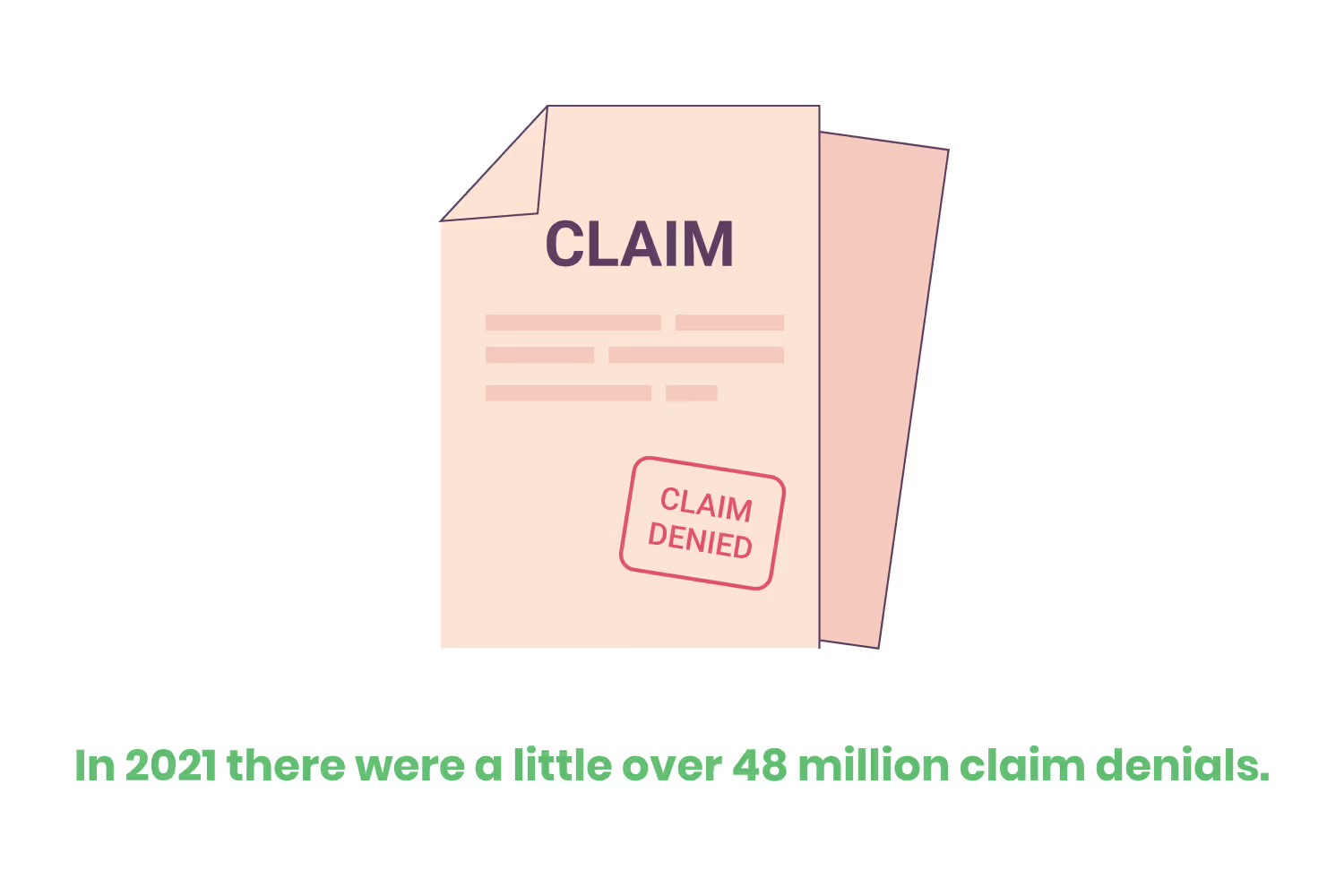
After you complete and submit the internal appeal, the insurance company must notify you with a written decision following their review. If they still deny the service, you can then look into an external review with an independent third-party.
Just a side note for you: before you request an external review, you must first ask the payer to reconsider the decision through an internal appeal. Can’t skip over this step!
Anyway, with an external review, insurance companies no longer get the final say over whether to pay a claim.
There are 2 steps in the external review process:
- File a written request within four months after the date you receive a claim denial notice.
- The external review will either side with the insurer and uphold their decision, or decide in your favor. No matter the outcome, your insurer must accept the external reviewer’s decision.
How to Handle Denial Codes by Category
Coverage & Eligibility Denials
(CO 1, CO 26, CO 27, CO 151, PR 31, PR 252, PR 272)
These denials occur when a patient’s insurance coverage is inactive, expired, or does not cover the service provided. Errors in policy details, incorrect eligibility verification, or insurance coordination issues can lead to these denials.
How to Handle:
- Verify patient eligibility before services using real-time eligibility tools or payer portals.
- Ensure correct policy details (e.g., name, date of birth, policy number).
- Check for coordination of benefits (COB) if the patient has multiple insurers.
- Bill the correct payer or confirm if the patient has secondary coverage.
- If no coverage exists, communicate with the patient about self-pay options.
Duplicate & Already Paid Claims
(CO 18, PI 18, OA 23, PI 29)
These denials happen when the same claim is submitted more than once or a service has already been paid under a different claim.
How to Handle:
- Check claim history to ensure it hasn’t already been processed.
- Use appropriate modifiers if a service was legitimately repeated (e.g., modifier 76 or 59).
- Request a review from the payer if the claim was denied in error.
- Ensure corrections are made before resubmission if the claim was refiled incorrectly.
Coding & Documentation Errors
Denials in this category are due to incorrect, missing, or incompatible coding. This includes invalid modifiers, diagnosis mismatches, or missing required documentation.
How to Handle:
- Double-check CPT, HCPCS, and ICD-10 codes for accuracy before submission.
- Ensure modifiers are appropriate to describe the service accurately.
- Review clinical documentation to ensure it supports the billed procedure.
- Utilize claim scrubbing tools to detect errors before submission.
- Appeal if necessary with corrected coding and supporting medical records.
Authorization & Precertification Issues
(CO 15, CO 50, CO 39, CO 197, PR 23)
These denials occur when a service requires pre-authorization but was performed without approval.
How to Handle:
- Verify authorization requirements before scheduling procedures.
- Obtain retroactive authorization if the payer allows it for medically necessary cases.
- Submit appeals with medical necessity documentation if an emergency prevented pre-approval.
- Monitor authorization approvals closely and document them in the patient’s file.
Fee Schedule & Contractual Adjustments
(CO 45, CO 59, CO 97, CO 122, PI 45)
These denials occur when the billed amount exceeds the allowable limit, the service is considered bundled, or payment adjustments are made based on a provider agreement.
How to Handle:
- Review payer fee schedules to ensure billed amounts align with contracted rates.
- Ensure correct use of modifiers to separate bundled services where applicable.
- Confirm the payer’s contract terms to understand the expected reimbursement.
- Appeal incorrect adjustments with documentation proving correct billing.
Medical Necessity & Policy Exclusions
(CO 167, CO 222, CO 242, PR 204)
These denials happen when the payer deems the service not medically necessary or considers it experimental, investigational, or non-covered.
How to Handle:
- Review the payer’s medical necessity policies for covered services.
- Submit appeals with clinical documentation that supports medical necessity.
- Request a peer-to-peer review if the denial is disputed by the provider.
- Consider alternative codes or modifiers that better reflect the service’s necessity.
How to Avoid Future Claim Denials?
For those who have been in the business for a while, you probably know a few tricks of the trade when it comes to avoiding these pesky claim denials. But I’m a firm believer that you can teach an old dog new tricks… not to call anyone an old dog here.
Anyway, as claim management processes and technology continue to advance, there will always be updates in the way medical billing teams approach filing claims. Whether it be through better education, more efficient streamlining of workflow, or more accurate data analysis, taking preventative measures will always be the first line of defense against denials.
Tip #1: Educate Your Team
Like I said, medical billing processes and technology are always changing. It seems like everywhere you turn you see some type of new billing software that claims to be the latest and greatest in the revenue cycle management space. And while that may well be, that doesn’t mean it will help a billing team that isn’t properly trained.

Just like technology and software is always changing, so are claim submission rules and regulations. You might as well throw your money away if you decide to invest in software while your employees don’t understand the data they are working with.
Different codes discontinue each year, while others are new to the scene. To limit the direct impact claim denials have on your cash flow, make sure your team stays on top of these rules and changes through continued and regularly updated education.
Tip #2: Stay Up To Date
Completing tasks manually can open up your administrative workflow to all kinds of (otherwise preventable) errors. Whether it be a typo or a late submission, as we can see from this blog, all mistakes are costly in one way or another.
That’s why investing in software to help you store and manage your claims is essential. Some examples of software that is helpful for submitting “clean” claims are:
- Medical Billing Solutions
- Medical Practice Management Software
- Medical Claims Processing Platforms
- Electronic Health Records
- Clearinghouse Services
One of the most valuable tools you should look for while shopping software is claim scrubbing. Clearinghouses offer this feature to ensure that there are no errors in your claims before you send them to an insurance payer. Think of this as a “spell check” for your claims.
Tip #3: Ensure Insurance Coverage & Eligibility
Don’t assume an insurance provider still covers a client every time they have an appointment. It isn’t uncommon for patients to change their insurance provider and forget to let the front desk know at their next visit. Sending your claims to the wrong insurance is an easy way to receive a denial in return. It’s also pretty easy to prevent.
Always run benefits eligibility checks before a patient visit to determine whether their coverage is different.
Tip #4: Real-Time Eligibility
One of the worst mistakes that healthcare organizations that have high denial rates do is not having an eligibility process in place.
Eligibility is the process of checking with an insurance payer that the services rendered to a patient are within the scope of their insurance plan. To put it more simply, insurance organizations don’t cover every procedure for all of their patients.
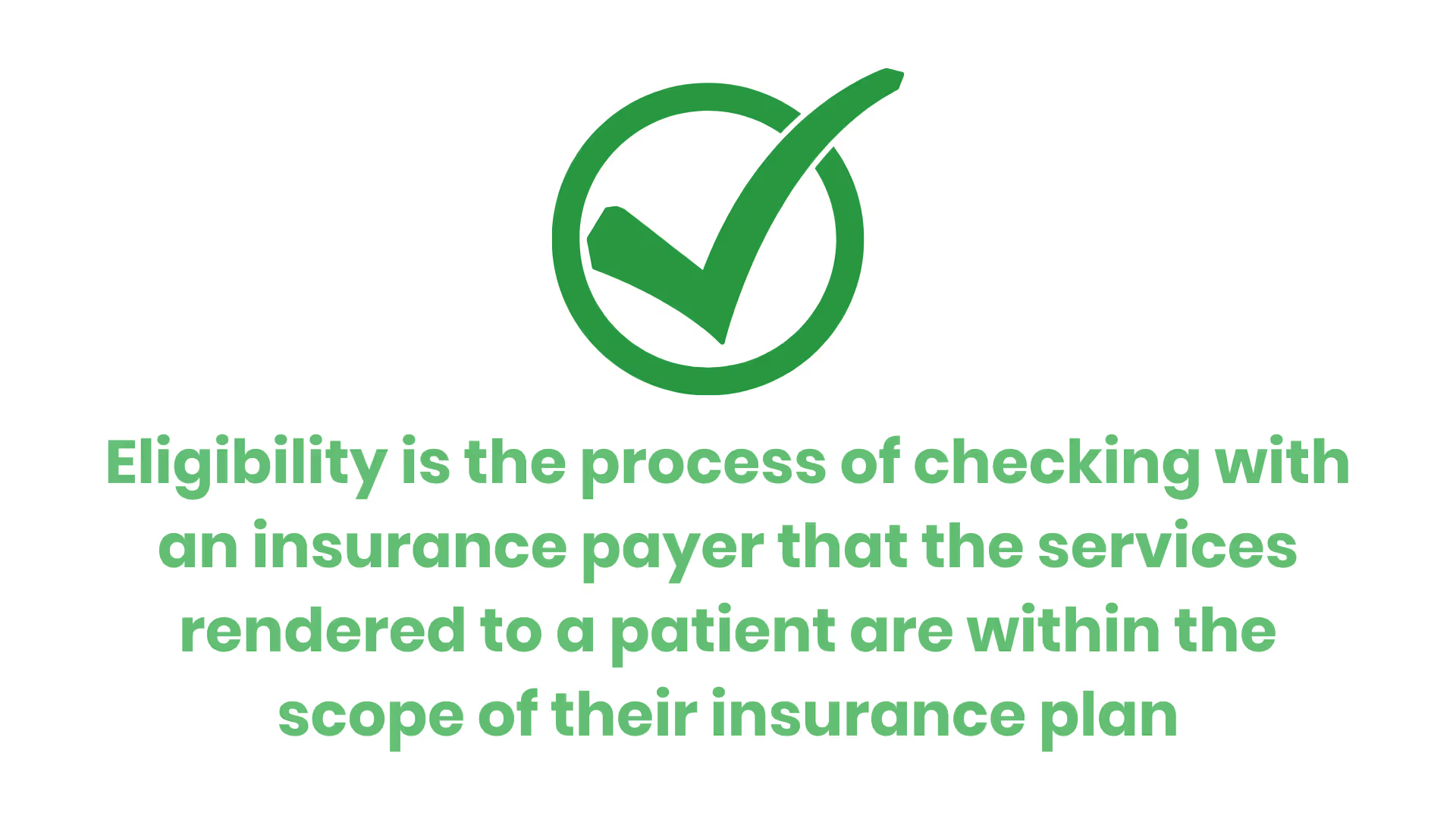
Now, I could write an entirely different blog post on the intricacies associated with different insurance plans. But, that would be closer to a dissertation than a blog post.
Anyway, the point I’m trying to make with all of this is that eligibility is a must-have process your organization should institute.
Of course, the best option for your organization to ensure that you’re keeping your denial rate down is to institute real-time eligibility. This is another feature your clearinghouse partners should offer. Basically, it speeds up the process via a lookup form.
Tip #4: Understand Your Payers
Understanding how your most common insurance payers operate is a great tool of the trade.
For example, Aetna might have a different timely filing limit for claim submissions compared to BlueCross BlueShield. In other words, if you sent one claim to each at the same time 120 days after the date of service, one might come back as a denial. Not good.
When considering your practice’s carriers, make sure you have the following information:
- The deadline, address, and submission requirements for timely filing. As well as the same information but for appeals.
- Deadline, address, and submission requirements for corrective claims.
- The contact information of the carrier representative you work with.
When you know your carrier’s policies, you are equipped to better respond to their actions. These companies will often include updated information on their websites, if not provide you with a hard copy of their policies when you sign a new contract with them.
Your clearinghouse partner should offload a lot of the pressure of understanding each of your insurance payers. Since they act as the central point and exist to help increase your bottom line, they should alert you of upcoming submission deadlines automatically.
Tip #5: Run Audits
A great way to tackle the issue of high denial rates is through strong strategies and processes. Okay, sounds great… but also very vague. You are probably wondering what constitutes a strong process!
Well, having a system to investigate unpaid claims, uncover insurance carrier trends, and better appeal rejections per the provider’s contract are three strategies to start with.
Laying the foundation with these strategies while educating your team to track, measure, and analyze denial trends can help better prevent errors and categorize denials.
Tip #6: Track the Claim Process
Have you ever heard of the saying “just trust the process”?
It’s a great saying and can apply to many different scenarios, but not ones having to do with processing claims. As much as I would love to tell you that all you need to do is worry about getting that claim out the door to the insurance carrier, I’d be lying to you.
Following-up with claim submissions is key. Keeping track of the claim throughout the payment process can help you catch problems early. The lifecycle of a claim needs monitoring at every stage to ensure a streamlined and efficient process.
Continuing to stay alert for any errors in the claims process means finding solutions faster and avoiding lost or delayed revenue.
Tip #7: Data Entry Errors
Front-end claim systems are pretty stingy when it comes to what they will reject and what they will accept. In fact, millions of claims are automatically denied due to data entry errors such as misspelled names, incorrect ID numbers, etc.
A common data entry error would be recording a patient’s name by their nickname instead of their legal name. So let’s say Bob comes in for an appointment, so you record his name as Bob instead of Robert (as it appears on the insurance card).
This situation may cause the claim to be rejected. Make sure you verify all of the patient’s insurance and demographic information before their visit, and then again when they come in for the appointment.
Conclusion
Running into claim denials is going to be inevitable. It’s not a question of whether or not health insurance companies will deny claims, but instead when and why.
Treating each denial as a learning experience will help signify workflow issues that you can not only correct, but then prevent from happening again in the future. Preventing denials is the easiest and most cost effective way to increase your revenue cycle efficiency.
In the ever-changing world of health claims, denials don't have to be a dead end.
With over two decades in the business and expert knowledge of claim-handling strategies, our clearinghouse solution allows you to focus on doing what matters most—building your practice!
Enjoy lightning-fast processing times with greater administrative efficiency; it's never been easier.
Emphasize your product's unique features or benefits to differentiate it from competitors
In nec dictum adipiscing pharetra enim etiam scelerisque dolor purus ipsum egestas cursus vulputate arcu egestas ut eu sed mollis consectetur mattis pharetra curabitur et maecenas in mattis fames consectetur ipsum quis risus mauris aliquam ornare nisl purus at ipsum nulla accumsan consectetur vestibulum suspendisse aliquam condimentum scelerisque lacinia pellentesque vestibulum condimentum turpis ligula pharetra dictum sapien facilisis sapien at sagittis et cursus congue.
- Pharetra curabitur et maecenas in mattis fames consectetur ipsum quis risus.
- Justo urna nisi auctor consequat consectetur dolor lectus blandit.
- Eget egestas volutpat lacinia vestibulum vitae mattis hendrerit.
- Ornare elit odio tellus orci bibendum dictum id sem congue enim amet diam.
Incorporate statistics or specific numbers to highlight the effectiveness or popularity of your offering
Convallis pellentesque ullamcorper sapien sed tristique fermentum proin amet quam tincidunt feugiat vitae neque quisque odio ut pellentesque ac mauris eget lectus. Pretium arcu turpis lacus sapien sit at eu sapien duis magna nunc nibh nam non ut nibh ultrices ultrices elementum egestas enim nisl sed cursus pellentesque sit dignissim enim euismod sit et convallis sed pelis viverra quam at nisl sit pharetra enim nisl nec vestibulum posuere in volutpat sed blandit neque risus.

Use time-sensitive language to encourage immediate action, such as "Limited Time Offer
Feugiat vitae neque quisque odio ut pellentesque ac mauris eget lectus. Pretium arcu turpis lacus sapien sit at eu sapien duis magna nunc nibh nam non ut nibh ultrices ultrices elementum egestas enim nisl sed cursus pellentesque sit dignissim enim euismod sit et convallis sed pelis viverra quam at nisl sit pharetra enim nisl nec vestibulum posuere in volutpat sed blandit neque risus.
- Pharetra curabitur et maecenas in mattis fames consectetur ipsum quis risus.
- Justo urna nisi auctor consequat consectetur dolor lectus blandit.
- Eget egestas volutpat lacinia vestibulum vitae mattis hendrerit.
- Ornare elit odio tellus orci bibendum dictum id sem congue enim amet diam.
Address customer pain points directly by showing how your product solves their problems
Feugiat vitae neque quisque odio ut pellentesque ac mauris eget lectus. Pretium arcu turpis lacus sapien sit at eu sapien duis magna nunc nibh nam non ut nibh ultrices ultrices elementum egestas enim nisl sed cursus pellentesque sit dignissim enim euismod sit et convallis sed pelis viverra quam at nisl sit pharetra enim nisl nec vestibulum posuere in volutpat sed blandit neque risus.
Vel etiam vel amet aenean eget in habitasse nunc duis tellus sem turpis risus aliquam ac volutpat tellus eu faucibus ullamcorper.
Tailor titles to your ideal customer segment using phrases like "Designed for Busy Professionals
Sed pretium id nibh id sit felis vitae volutpat volutpat adipiscing at sodales neque lectus mi phasellus commodo at elit suspendisse ornare faucibus lectus purus viverra in nec aliquet commodo et sed sed nisi tempor mi pellentesque arcu viverra pretium duis enim vulputate dignissim etiam ultrices vitae neque urna proin nibh diam turpis augue lacus.



![[ANSWERED] What is a Long-Term Care (LTC) Pharmacy](https://cdn.prod.website-files.com/67e2b8210878abcba6f91ae6/68d687806a075a1cf64659b0_WhatisLongTermCarePharmacy_925.avif)
